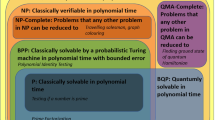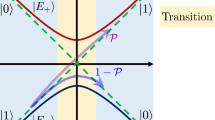Abstract
In this article we assess a novel quantum computation paradigm based on the resonant transition (RT) phenomenon commonly associated with atomic and molecular systems. We thoroughly analyze the intimate connections between the RT-based quantum computation and the well-established adiabatic quantum computation (AQC). Both quantum computing frameworks encode solutions to computational problems in the spectral properties of a Hamiltonian and rely on the quantum dynamics to obtain the desired output state. We discuss how one can adapt any adiabatic quantum algorithm to a corresponding RT version and the two approaches are limited by different aspects of Hamiltonians’ spectra. The RT approach provides a compelling alternative to the AQC under various circumstances. To better illustrate the usefulness of the novel framework, we analyze the time complexity of an algorithm for 3-SAT problems and discuss straightforward methods to fine tune its efficiency.



Similar content being viewed by others
Notes
In this case, the initial state \(\left| \Psi _s \right\rangle \) is also the eigenstate of \(H_s\) with eigenvalue \(-1\) such that \(\left| \Psi _s \right\rangle \) that will be excited to other eigenstates with higher eigenvalues.
On Mathematica, harmonicnumber(M,2), is bounded from above by \(\frac{\pi ^2}{6} - \frac{2M-1}{2M^2}\) by use of Laurent series.
On Mathematica, harmonicnumber(M,1/2)/M, is approximately \(2\sqrt{\frac{1}{M}}\) by Puiseux series.
On Mathematica, (harmonicnumber \(((M*(M+1)/2),1/2))/M\) converges around 1.5. Since \(K=\frac{M(M+1)}{2}\), then \( O\left( \frac{2 \times 1.5\sqrt{N}}{\gamma (M+1)}\right) \simeq O\left( \sqrt{N}/(n\gamma )\right) \).
References
Deutsch, D., Jozsa, R.: Rapid solutions of problems by quantum computation. Proc. R. Soc. Lond. A 439, 553–558 (1992)
Shor, P.: Algorithms for quantum computation: discrete logarithms and factoring. In: Proceedings of the 35th IEEE Symposium on Foundations of Computer Science. pp. 124–134 (1994)
Denchev, V., Boixo, S., Isakov, S., Ding, N., Babbush, R., Smelyanskiy, V., Martinis, J., Neven, H.: What is the computational value of finite range tunneling. arXiv:1512.02206 [quant-ph]
Crosson, E., Harrow, A.: Simulated quantum annealing can be exponentially faster than classical simulated annealing. arXiv:1601.03030 [quant-ph]
Farhi, E., Goldston, J., Gutmann, S., Sipser, M.: Quantum computation by adiabatic evolution. MIT-CTP-2936 (2000)
Dam, V., Mosca, M., Vazirani, U.: How powerful is adiabatic quantum computation, FOCS ’01. In: Proceedings of the 42nd IEEE symposium on Foundations of Computer Science, pp. 279–287 (2001)
Wang, H., Ashhab, S., Nori, F.: Quantum algorithm for obtaining the energy spectrum of a physical system. Phys. Rev. A 85, 062304 (2012)
Wang, H., Fan, H., Li, F.: A quantum algorithm for solving some discrete mathematical problems by probing their energy spectra. Phys. Rev. A 89, 012306 (2013)
Wiebe, N., Berry, D., Hyer, P., Sander, B.: Simulating quantum dynamics on a quantum computer. J. Phys. A: Math. Theor. 44(44) (2011)
Laumann, C., Moessner, R., Scardicchio, A., Sondhi, S.: Quantum annealing: the fastest route to quantum computation? Eur. Phys. J. Spec. Top. 224, 75 (2015)
Wang, H., Ashhab, S., Nori, F.: Quantum algorithm for simulating the dynamics of an open quantum system. Phys. Rev. A 83, 062317 (2011)
Scully, M., Zubairy, M.: Quantum Optics. Cambridge University Press, Cambridge (1997)
Terhal, B., DiVincenzo, D.: Problem of equilibration and the computation of correlation functions on a quantum computer. Phys. Rev. A 61, 022301 (2000)
Wang, H.: Quantum algorithm for obtaining the eigenstates of a physical system. Phys. Rev. A 93, 052334 (2016)
Biamonte, J., Love, P.: Realizable hamiltonians for universal adiabatic quantum computers. Phys. Rev. A 78, 012352 (2008)
Biamonte, J.: Non-perturbative k-body to two-body commuting conversion hamiltonians and embedding problem instances into Ising spins. Phys. Rev. A 77, 052331 (2008)
Liu, W.Z., Zhang, J.F., Deng, Z.W., Long, G.L.: Simulation of general three-body interactions in a nulcear magnetic resonance ensemble quantum computer. Sci. China Ser. G Phys. Mech. Astron. 51, 1089–1096 (2008)
Cetina, M., Bylinskii, A., Karpa, L., Gangloff, D., Beck, K.M., Ge, Y., Scholz, M., Grier, A.T., Chuang, I., Vuletic, V.: One-dimensional array of ion chains coupled to an optical cavity. New J. Phys. 15, 053001 (2013)
Messiah, A.: Quantum Mechanics, vol. II. Amsterdam, Wiley, North Holland, New York (1976)
Wong, T., Meyer, D.: Irreconcilable difference between quantum walks and adiabatic quantum computing. Phys. Rev. A 93, 062313 (2016)
Mézard, M., Parisi, G., Zecchian, R.: Analytic and algorithmic solution of random satisfiability problems. Science 297(5582), 812–815 (2002)
Peng, X., Liao, Z., Xu, N., Qin, G., Zhou, X., Suter, D., Du, J.: Quantum adiabatic algorithm for factorization and its experimental implementation. Phys. Rev. Lett. 101, 220405 (2008)
Crawford, J., Auton, L.: Experimental results on the crossover point in satisfiability problems. In: Proceedings of the 11th National Conference on AI, pp. 21-27 (1993)
Mitchell, D., Selman, B., Levesque, H.: Hard and easy distributionsof SAT problems. In: Proceedings of the 10th National Conference on AI, pp. 459-465 (1992)
Huberman, B.A., Hogg, T.: Phase transitions in artificial intelligence systems. Artif. Intell. 33(2), 155–171 (1987)
Garraway, B.: The Dicke model in quanutm optics: Dicke model revisited. Philos. Trans. R. Soc. A 369, 1137–1155 (2011)
Grover, L.: A fast quantum mechanical algorithm for database search. In: Proceedings of the 28th Annual ACM Symposium on the Theory of Computing, pp. 212–219 (1996)
Ghoreishi, S., Sarbishaei, M., Jvidan, K.: Entanglement between two Tavis–Cummings systems with N = 2. Int. J. Theor. Math. Phys. 2(6), 187–195 (2012)
Horvath, L., Sanders, B.: Photon coincidence spectroscopy for two-atom cavity quantum electrodynamics. J. Mod. Opt. 49(1–2), 285–303 (2002)
Acknowledgements
C. C. gratefully acknowledges the support from the State University of New York Polytechnic Institute.
Author information
Authors and Affiliations
Corresponding author
Rights and permissions
About this article
Cite this article
Chiang, CF., Hsieh, CY. Resonant transition-based quantum computation. Quantum Inf Process 16, 120 (2017). https://doi.org/10.1007/s11128-017-1552-8
Received:
Accepted:
Published:
DOI: https://doi.org/10.1007/s11128-017-1552-8




